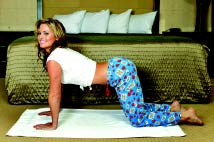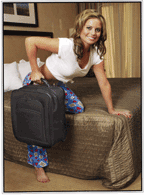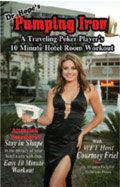|
Trusting Your Gut

I once made what I thought was a big mistake
in tournament play (I showed up—just kidding). Because I was
convinced it was a mistake, I asked some fellow pros what they would
have done in that spot. Over the course of several months, I asked
Chris Ferguson, Freddie Deeb, Annie Duke, and dozens of other pros
and they all told me that they would have done exactly what I’d
done. Are you curious what the situation was yet? Here’s the
deal (literally):
It was in the Senior Event (that’s right,
everyone there was at least in their fourth year of high school)
during the 2005 36th Annual World Series of Poker at the Rio Casino
in Las Vegas. 825 players entered this event, but at this point
in the tournament, there were only 50 players left. I had been on
a rush and I had milked it for all it was worth. I had a monster
stack; I was the chip leader, so I decided to change gears and only
play premium hands and perhaps occasionally cheaply bully a small
stack out of a pot. I figured that by doing this I could coast to
the final table.
The next closest player was Paul McKinney, who I
had seen play from coast to coast, but had never personally gone
up against. Since this was my first time playing with him, I paid
particularly close attention to his play. In the hours leading up
to the hand that we will discuss, I saw him move all-in with pocket
Jacks and pocket Queens before the flop. He won both those hands.
In fact, by the time of our confrontation, he was second chip leader
in the tournament with $40,000 in chips. The third place chip leader
had about $25,000 and I had a whopping $72,000.
Here’s the hand: The blinds were $500 and
$1,000. The antes were $100. I was first to act and I raised to
$3,500. I had a monster, pocket Kings. Everyone folded to Paul,
who was in the cut-off seat. He moved all-in. The button and the
blinds all folded to me and I asked for a chip count. Paul had a
little over $40,000. My gut told me to fold. I reasoned that I didn’t
need to play such a big pot.
Only if he had Aces would I be a big dog, but did
he have Aces? I recalled that he made the same move with Jacks and
then again with Queens. But so what, my gut told me, it’s
okay to lay down the best hand. If you throw it away, you’ll
still have over $68,000 in chips and coast to the final table. I
kept thinking, “Don’t play such a big pot—you
don’t need to—pick a better spot against a smaller stack.”
But then I started second-guessing: “If he
had Aces, why would he bet so much? Wouldn’t he want the action?
He probably doesn’t have them.” (My gut told me again
that I didn’t need this pot, and to let him have it. It’s
okay to throw away the best hand from time to time.) Then I thought
(are you following all these thoughts?), “If I win this pot
I’ll have over $112,000 in chips and even if I lose I’ll
still have a slightly better than average stack.” So I called.
He had Pocket Aces. They stood up and I lost over half my stack.
By the time we got down to 30 players, I was a short
stack with only $10,000 in chips. Paul had limped from middle position
and I was on the button with K Q suited. The blinds were $1,500
and $3,000 with an ante of $400. Since Paul had shown weakness with
his limp, I moved all-in. This time Paul had slow-played pocket
Aces and sucked me into making a move at the pot. His Aces held
up and I busted out in 30th place.
I always felt that that call was a mistake; it bothered
me for months, but nobody would agree with me that that had been
a mistake. Chris and Annie and a bunch of other pros said that they
would have called in that spot. I still felt the call was a mistake
and I just couldn’t let it go; I wanted someone who I respected
as a player to tell me otherwise.
Finally, one night at a party for Doyle Brunson
at the Bellagio, I asked T. J. Cloutier. He passed along these words
of wisdom to me: “Always go with your gut. If you’ve
got a strong feeling, go with it.” Thank you, T. J.
Later that night, I asked Jen Harmon the same question
and she agreed with the lay down in that spot. Thank you, Jen. These
were the only two pros out of dozens that agreed with me. I had
made a mistake and should have gone with my gut feeling and laid
that hand down. It may sound like I became a little obsessive about
finding someone who agreed with me, but thanks to T. J. and Jen,
I feel more confident in trusting my inner poker player. You should
try it too.
So what have we learned here?
1. Always trust your gut.
2. Don’t get married to a big hand.
3. Listen to your inner poker player.
4. Always brush and floss twice daily.
Be sure and read my next article, "Luck and
a Positive Attitude."
So until next time, remember
the number one thing in poker is to have fun and enjoy it. It’s
not whether you win or lose that counts; it’s whether
I win or lose.
C’ya
Dr. Hope, J.A.P.D
(Just A Pretend Doctor)
To comment on this article click here.
This
article was taken from a book designed to keep poker players in shape
while they are on the road. This easy 10 minute hotel room
workout has helped some world-class poker players stay in shape.
Dr. Hope, for one. Anny Duke told Dr. Hope that Eric
Seidel uses this workout whenever he is on the road. T.J.
Cloutier told Dr. Hope, "There's some good stuff in that book."
The name of the book is:
Pumping Iron: A Traveling Poker Player’s 10 Minute Hotel Room
Workout. Here are some pictures from
it:



Here's
what people are saying about this book:
Absolutely the best book I've ever read in my whole
life! It's hilarious and well written.-- Dr. Hope s mom
If you travel you need this book! You should buy at least one copy
- no wait- at least three copies, of this fantastic innovative
book! --Dr. Hope's publisher

Want
it?
CLICK
HERE Help
support this site by
purchasing
your copy of
Dr.
Hope’s Pumping
Iron: A Traveling Poker Player’s
10 Minute Hotel Room Workouttoday!
|